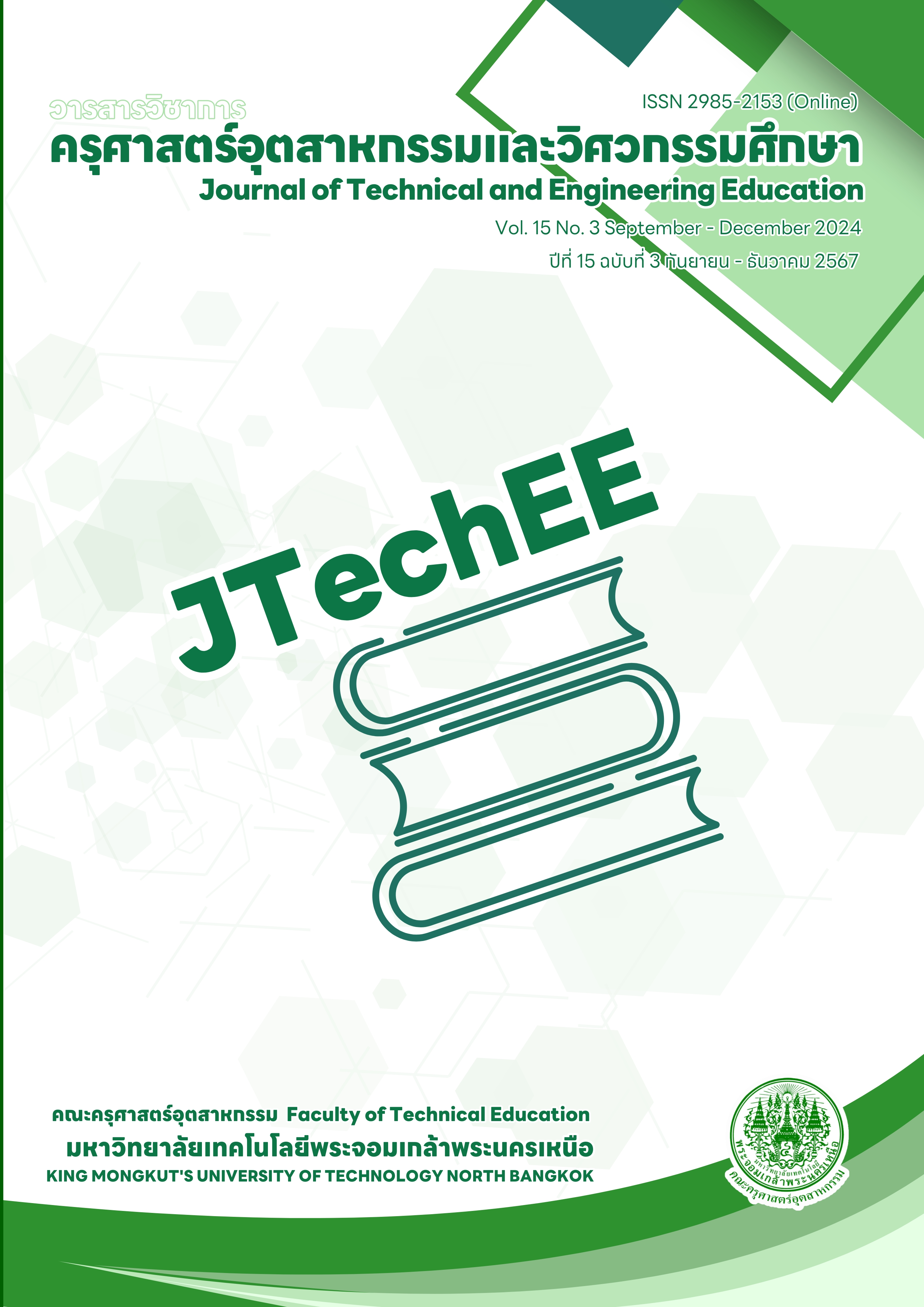การพัฒนาชิ้นงานตัวอย่างและสื่อการสอนสำหรับการศึกษาปัจจัยที่มีผลต่อรอยเชื่อม
Main Article Content
บทคัดย่อ
งานเชื่อมมีความสำคัญในงานก่อสร้างและอุตสาหกรรมต่าง ๆ มากมาย ทำให้มีความต้องการช่างเชื่อมที่มีคุณภาพ ซึ่งหมายถึงมีความต้องการครูช่างเชื่อมที่มีความรู้ ความชำนาญมากเช่นกัน ครูช่างเชื่อมที่มีคุณภาพจะสามารถถ่ายทอดความรู้และทักษะการเชื่อมได้อย่างถูกต้องและครบถ้วน ทำให้ผู้เรียนมีพื้นฐานที่ดีในการประกอบอาชีพ จากงานวิจัยที่ผ่านมา แม้จะมีการศึกษาเกี่ยวกับปัจจัยต่าง ๆ เช่น กระแสไฟเชื่อม และความเร็วในการเคลื่อนที่หัวเชื่อมที่ส่งผลต่อรอยเชื่อมอยู่บ้าง แต่สื่อการเรียนการสอนที่เกี่ยวกับงานเชื่อมยังมีอยู่ไม่มากนัก งานวิจัยนี้ จึงได้จัดทำชิ้นงานตัวอย่างและสื่อการสอนสำหรับการศึกษาปัจจัยที่มีผลต่อรอยเชื่อม โดยใช้กระบวนการเชื่อมอาร์กโลหะด้วยแก๊สปกคลุม (Gas Metal Arc Welding: GMAW) ของหุ่นยนต์เชื่อม เพื่อหาคุณภาพของชิ้นงานตัวอย่างและสื่อการสอน เปรียบเทียบผลสัมฤทธิ์ทางการเรียน ก่อนเรียนและหลังเรียน และเพื่อหาค่าความพึงพอใจของผู้เรียนที่มีต่อชิ้นงานตัวอย่างและสื่อการสอน เครื่องมือที่ใช้ในงานวิจัย ประกอบด้วย การสร้างชิ้นงานตัวอย่าง ที่ใช้กระแสไฟเชื่อม 190A, 210A, และ 250A ความเร็วในการเคลื่อนที่หัวเชื่อม 3.0, 3.5 และ 4.0mm/s โดยได้กำหนดให้แรงดันเชื่อมและระยะยืดของปลายลวดเชื่อมคงที่ รวมทั้งใช้แก๊สคาร์บอนไดออกไซค์ในการปกคลุม นอกจากนี้ยังมีแผนการสอน สื่อการสอนและแบบทดสอบ กลุ่มตัวอย่างที่ใช้ในงานวิจัยได้แก่ นักศึกษาชั้นปีที่ 1 สาขาวิชาวิศวกรรมอุตสาหการ คณะครุศาสตร์อุตสาหกรรม จำนวน 15 คน สถิติที่ใช้วิเคราะห์ข้อมูลได้แก่ ค่าเฉลี่ย ส่วนเบี่ยงเบนมาตราฐาน และการทดสอบค่าที (t-test for dependent samples) โดยผลการวิจัยพบว่า คุณภาพของชิ้นงานตัวอย่างและสื่อการสอนในการศึกษาปัจจัยที่มีผลต่อรอยเชื่อมมีค่าเฉลี่ยในภาพรวมเท่ากับ 4.18 (S.D.=0.71) มีความเหมาะสมอยู่ในระดับมาก เมื่อแยกวิเคราะห์ในแต่ละด้าน พบว่าระดับความเหมาะสมของการวัดและการประเมินผลมีค่ามากที่สุด รองลงมาคือด้านเนื้อหาและด้านชิ้นงานตัวอย่างและสื่อการสอน ตามลำดับเมื่อนำชิ้นงานตัวอย่างและสื่อการสอนนี้ไปใช้สอนจริง พบว่าทำให้ผู้เรียนมีผลสัมฤทธิ์ทางการเรียนหลังเรียนสูงกว่าก่อนเรียนอย่างมีนัยสําคัญทางสถิติที่ระดับ 0.05 และผู้เรียนมีความพึงพอใจต่อชิ้นงานตัวอย่างที่ใช้เป็นสื่อการสอนในการศึกษาปัจจัยที่มีผลต่อรอยเชื่อมอยู่ในเกณฑ์มากที่สุด ( 𝑥̅ =4.51, S.D.=0.68)
Article Details

อนุญาตภายใต้เงื่อนไข Creative Commons Attribution-NonCommercial-NoDerivatives 4.0 International License.
ลิขสิทธิ์และเนื้อหาในเว็ปไซต์ของวารสาร (รวมถึง โดยไม่จำกัดเฉพาะ เนื้อหา รหัสคอมพิวเตอร์ งานศิลป์ ภาพถ่าย รูปภาพ โสตทัศนวัสดุ) เป็นกรรมสิทธิ์ของวารสารและผู้ได้รับการโอนสิทธิทุกราย
เอกสารอ้างอิง
Baskoro, A. S., Hidayat, R., Widyianto, A., Amat, M. A., & Putra, D. U. (2020). Optimization of Gas Metal Arc Welding (GMAW) Parameters for Minimum Distortion of T Welded Joints of A36 Mild Steel by Taguchi Method. Materials Science Forum , 1000, 356 - 363. DOI : 10.4028/www.scientific.net/MSF.1000.356
Choondee, A. (2019). Are Handmade Teaching Materials Still Needed in the Digital Age? Journal of Early Childhood Education Management, 1(1), 63 - 76. [in Thai]
Dejagupta, P., & Kengkan, P. (2012). Innovate Learning with Classroom Action Research. Bangkok: Publisher of Chulalongkorn University. [in Thai]
Halmshaw, R. (1991). Non-destructive testing techniques. Butterworth-Heinemann.
Jenney, C., & O’Brien, A. (2004). Welding Handbook. American Welding Society.
Kalnaowakul, P., & Yingsamphancharoen, T. (2022). Differenct Welding Current on Mechanical and Electrochemical Behavior of FCAW ASTM A36 Carbon Steel Joints. Suranaree Journal of Science & Technology, 29(6), 030083(1-9).
Kolb, D. A. (1984). Experiential learning: Experience as the source of learning and development. Prentice Hall.
Komonhirun, W., & Yingsamphancharoen, T. (2006). The Instructional Multimedia on the Radiographic Analysis in Welding. The Journal of Industrial Technology, 2, 77 - 82. [in Thai]
Kunukunladej, N., Suksakulchai, S., & Kaewprapan, W. (2016). The Development of Interactive Experiment Kit on DC Bridge Circuits. Rajamangala University of Technology Srivijaya Research Journal, 8(1), 125 - 135. [in Thai]
Lekphet, W., Pibool, S., Boonpichayapha, T., Boonniyom, S., Kumsapaya, C., & Plirdpring, J. (2021). Development of Field Learning Activity Packages on Dye–Sensitized Solar Cells Fabrication to Connect Green Energy Education. Journal of Research Unit on Science, Technology and Environment for Learning, 13(1),
- 59. [in Thai]
Sributtha, W., Kaya, N., Chumeka, A., Jaieu, J., & Bootchai, S. (2024). The Development of an Online Engineering Economy Course. 16th National Conference on Technical Education. Bangkok. [in Thai]
Srikarun, B. (2017). Metallurgical and Mechanical Properties of Hardfacing of 3.5% Cr Steel. Prince of Songkla University. [in Thai]
Srisa-ard, B. (2011). Introduction to research. Bangkok: Suweerivasarn. [in Thai]
Thanyaprasertsiri, N., Stirayakorn, P., & Methapatra, P. (2023). The Development of Learning and Teaching Model of Vocational Education for Promoting Creativity in Problem Solving. Journal of MCU Peace Studies, 11(3), 1068 - 1081. [in Thai]
Tukahirwa, G., & Wandera, C. (2023). Influence of Process Parameters in Gas-Metal Arc Welding (GMAW) of Carbon Steels. In S. Kumar, Welding - Materials, Fabrication Processes, and Industry 5.0.
DOI: 10.5772/intechopen.1002730
Wattanathum, P. (2024, April). Welding Parameter. Retrieved from https://www.longwellthai.com/17478582/welding-parameter


